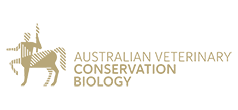Conservation Biology

The Australian Veterinary Conservation Biology Group concerns itself with wildlife medicine and conservation, and in Australia, we have some of the most unique and endangered native animals in the world. The Australian Veterinary Conservation Biology Group applies a multi-disciplinary approach to conservation and involves working with a variety of stakeholders to promote sound science and evidence-based wildlife management.
The involvement of veterinarians with wildlife goes well beyond the activities of zoo veterinarians, and this was one of the drivers in the establishment of an AVA group that would cater for the needs and aspirations of those with an interest in the conservation of biodiversity.
In defining the scope for such a group there was also a need to choose a name for the Group that was descriptive of its aims. In this regard, it was decided that the term "veterinary conservation biology (VCB)" was an accurate statement of the wide spectrum of activities that it would include. The term "conservation biology" was already being widely used to describe a new multidisciplinary science that seeks to understand the nature and scope of human impacts on biodiversity and to seek practical solutions to these. Adding the word "veterinary" simply emphasized the potential role for veterinarians in teams with other biologists, wildlife managers, economists and other advisers to governments and farmers alike. It then became possible to describe the range of activities encompassed by the term VCB, which fall under these five headings:
- Conservation medicine - wildlife health in all its contexts from ecosystem health involving free-living populations to the health and welfare of captive animals, including sick, injured or orphaned fauna in the hands of veterinarians or wildlife carers. There is increasing interest in defining the links between wildlife health, human health and the health of livestock, with the Australian Wildlife Health Network (AWHN) now one of the key players. With the additional work of the Australian Registry of Wildlife Health and a number of other facilities and it is fair to say that conservation medicine has made immense bounds in the last decade or so.
- Conservation of endangered species - both in situ and ex-situ activities involving the use of tools like enhanced reproductive technologies, conservation genetics, powerful data recording systems and databases and the work of Taxon Advisory Groups under the Australian Species Management Plan (ASMP). There are many roles for veterinarians in these fields, including an oversight of animal welfare.
- Sustainable farming including off-reserve conservation - there is now an understanding of the need to take a "whole farm" approach when giving advice to landowners. This includes control of invasive species and the development of land use strategies that include incentives to preserve native vegetation. Every large animal practitioner can play a part in this.
- Sustainable utilisation of wildlife - from the commercial harvest of free-living animals (e.g. kangaroos, feral pigs, and fisheries) to modern game farming and ranching (crocodiles, deer, emus) and ecotourism. There is a multiplicity of roles for veterinarians, from health and production issues to animal welfare.
- Import and export of wildlife - both quarantine and conservation activities under CITES and other treaties and conventions.
Our members are involved in numerous activities.
The Australian Veterinary Conservation Biology group contributes to the Policy Advisory Council by drafting policies relating to conservation biology. Australian Veterinary Conservation Biology group members have been involved in the development of many AVA policies including zoo animals, circus animals, hunting and fishing, control of feral animals and utilisation of wildlife. For a full list of AVA policies, please see AVA Policy & Advocacy.
Where can a career in Conservation Biology take you?
Some of our members work in private practice and have a professional or personal interest in the Conservation Biology ‘on the side’. Others work full-time in veterinary conservation biology roles. A career in veterinary conservation biology can take you on many adventures, including:
- research in universities or other institutions such as CSIRO
- being a zoo and wildlife park veterinarian
- working with the government to provide clinical and field services or research, analysis, and policy development
- serving on animal ethics committees concerning wildlife
- providing veterinary expertise to wildlife advisory groups, e.g. kangaroo management and feral animal control
- fisheries management and aquaculture
- working with the mining or agriculture sector to rehabilitate an environment post-mining or degradation
- international trade monitoring and regulation in exotic animals and animal products
- UN Environment Program and other international roles
- working with indigenous communities (e.g. AMRRIC)
- improving the care of wildlife in day-to-day clinical practice

